A Map of Socio-spatial Exclusion in Tokyo, from the Perspective of Homeless People
In November 2020, in Shibuya, the most prosperous downtown area in Tokyo, Japan, an older woman resting on a bench at a bus stop late at night was struck on the head by a man with a plastic bag filled with rocks and killed. The woman had been homeless and had only eight yen in her pocket. According to the testimony of a resident of the area, the woman had been coming to that bench every day, dragging her trolley bag after the last bus of the day had departed; she would rest on the bench and leave before the first bus arrived. The bench at the bus stop had been her temporary home. Five days after the incident, a man in his forties, accompanied by his mother, surrendered himself at the police station and was arrested. He is the son of a wealthy real estate owner who lived nearby. Since quitting his job due to depression in his youth, he had been mostly confined to his room almost as in the case of hikikomori (acute social withdrawal), occasionally helping out at his family’s liquor store and participating in local clean-up volunteer activities. On the day before the incident, according to his statement to the police, he had tried to negotiate with (or order) the woman to get out of the bus stop so that he could give her some money, but she did not comply, which angered him, and he committed the crime the next day. He had long found the presence of the homeless in his neighborhood disturbing, and he had wanted her to go away. Before the incident, several neighbors had noticed the woman resting late at night at that bus stop. Some people were concerned about her and had asked her if she was okay. However, no one knew who she was or from where she had come.
The victim’s name was Misako Ōbayashi, a 64-year-old woman, who was homeless when she was killed. Her trolley bag, which she had been lugging, was filled with clothes and food. The police were able to identify her because, among her things, there was a note with her relatives’ contact information. She was single and had no children. She had worked for a supermarket as a temporary worker for approximately ten years, but due to the unstable work with the short-term contract, she had eventually been unable to pay her rent and had become homeless. At first she had slept in internet cafés and other places, but in the last few years she had no work and was forced to sleep at the bus stop. Her siblings and friends were unaware of the extent of her financial predicament. Her co-workers at the same supermarket were aware of the harshness of her life at the time, but they were hesitant to help her because they knew that she had a strong will and desire to overcome the situation on her own without asking for help.

This incident, which happened during my fieldwork, seems to symbolically represent urban social exclusion, in some aspects, resulting from the friction of social relations and ideologies, such as a “tragic intimacy of proximity” and the “demonization of the other.” Simultaneously, we can see the spatial embodiment of exclusion here. Soon after the incident, I visited the scene. The bus stop is located along the national highway, a short distance from the train station. During the daytime, the area has a lot of traffic, meaning that geographically it is located in the heart of Tokyo, but late at night it becomes rather peripheral and temporarily disconnected from social interaction. The bench where Ms. Ōbayashi had rested every night was located next to a large shiny electronic advertisement, and it was very small with a partition in the middle, clearly designed to prevent people from lying down. Seeing the bench made me wonder why she had chosen this spot to sleep. What did she think and feel every night that she spent here?
Lévi-Strauss argues that primitive societies “deal with strangers and deviants by swallowing them up, by making them their own and by gaining strength from them.” He calls these societies anthropophagic or cannibalistic. Modern societies, in contrast, are bulimic or anthropoemic; “they vomit out the deviant, keeping them outside of society or enclosing them in special institutions within their perimeters” (1992:287-8). Cities, particularly in advanced capitalist nations, are probably the symbolic space where this characteristic of modern society is most clearly expressed, as they are multi-sites where diverse cultural values, ideologies, and roots are heterogeneously and transnationally intermingled and conflicted under the globalization that accelerates the flow of people, goods, and resources (see Gupta and Ferguson 1992; Appadurai 1996; Massey 2005). Social exclusion usually manifests itself in inequalities in various dimensions, such as material consumption and accumulation, education, training, employment, welfare, and social connections (Burchardt, Le Grand, and Piachaud 1999:230). Byrne, however, emphasizes that in an advanced capitalist city, social exclusion is most explicitly expressed in space (2005:12).
The bus stop where the incident occurred is a precarious place that is temporarily marginalized. The 24-hour brightly lit electronic advertisement panel and the exclusionary design of the bench are set up with the intention of preventing people from resting there for a long time. It implies that this space itself had been excluding Ms. Ōbayashi even before the incident.
In the city, the agency of exclusion is embodied in various ways: an object with a defensive design, a hostile architecture, a surveillance camera, a planting project for urban beautification, and a tightening of regulations and privatization of public space. As discussed later in this project, these representations of “socio-spatial exclusion” are ubiquitous throughout Tokyo, and they are critical socio-environmental variables that condition and determine our daily lives and sometimes, at least in part, define the trajectory of our later life course (Byrne 2005:12). How this urban formulation, then, is experienced by a homeless subjected to exclusion?
For exploring the inquiry, this project makes a map based on the walking practice with the homeless. A map that provides spatial data can be a useful method to visualize the actual spatial arrangement of socio-spatial exclusion in the city. In particular, map-making with local people to visualize and challenge a hegemonic discourse and system is called counter cartography. Counter cartography has recently been used in the realm of cultural anthropology to collect information on and better understand an area’s physical and social context, and spatial embodiment in the field (see Wood 2012; Mesquita 2018). Maps produced by counter cartography are often understood as exact representations of reality.
The walking was conducted in Shibuya at different times, for approximately an hour each, on 15th December 2020 with Ms. M and 30th September 2021 with Mr. H. The routes were decided by Ms. M and Mr. H and I just followed them while talking frankly. While walking, they shared with me the different aspects of the city that are difficult to notice from the “mainstream” perspective, but which certainly exist and form another urban landscape.
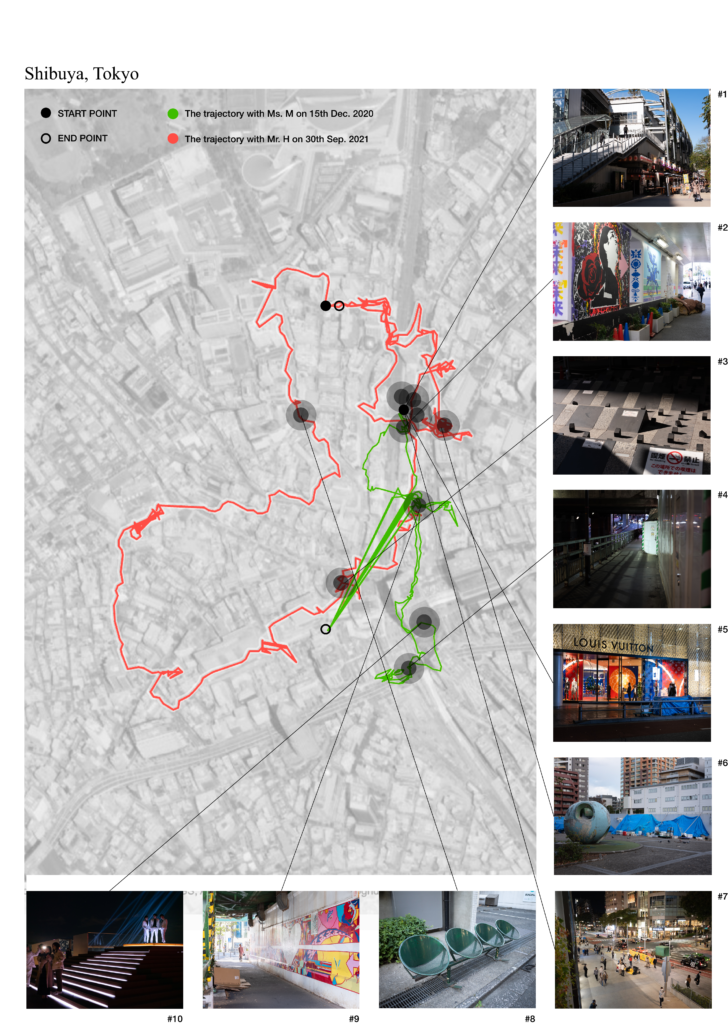
#1

In examining the relationship between homelessness and socio-spatial exclusion in Tokyo today, the impact of hosting the Olympic Games in 2020 is significant. The Olympics, as a “mega-event,” is more about investment in infrastructure and urban redevelopment than the games themselves, and thus it facilitates the spatial reorganization of the host city. However, the reorganization has an impact on the urban poor (Greene 2003; Bhan 2009; Newton 2009; Shin 2012).
The decision to host the Tokyo Olympics was made in 2013 and subsequently, redevelopment projects started up in various parts of Tokyo. Ms. M says, “Furthermore, I feel the ones that had already been underway before the decision to host the Olympics seemed to accelerate as if they had gained momentum.” The target areas of some of those projects include public spaces. In Shibuya Ward, the area this thesis focuses on, Miyashita Park was closed to be reconstructed into a large commercial facility in 2013, and Meiji Park was demolished to make way for the Olympic Stadium in 2016. The homeless people who had been living in these parks were forced to move to government-designated facilities, and those who refused it were forcibly evicted by the government and dispersed to the streets. However, with the dramatic large-scale redevelopment of the area around the station, spaces that used to be the margins on the streets for the homeless, such as under the elevated railway tracks and the underground passages of the station, have been transformed into spaces to be used. Ms. M says, “We are excluded from the park and kicked out from the streets. Where are we supposed to go?”
#2

It is not only the redevelopment that deprives the homeless of space on the streets. The area underneath the elevated railway tracks of Shibuya Station, which is a reasonable place for the homeless, is now occupied by flowerbeds and planters. This is said to be one of the greening campaigns of Shibuya Ward, but Ms. M says, “I wonder how much placing flowerbeds and planters under the elevated railway tracks, where there is no sunlight, contributes to greening.” Clearly, the intention here is to fill the dead space, where homeless people might stay, with something else. “If you see flowerbeds and planters in strange places, it is a sign that there used to be homeless people there,” Ms. M says.
It is difficult to notice the agency of exclusion embedded in objects such as flowerbeds and planters. They do not have an inherent intention of exclusion, but their placement transforms them into hostile architecture. Even I had not noticed them before walking around the city with Ms. M. However, once you recognize it, you realize how the city is full of such objects.
#3

Walking around the city, you can see not only flowerbeds and planters, but also larger objects that are placed to fill dead spaces, especially around train stations and inside train yards. This can be a part of urban planning to prevent the homeless from staying in or around train stations. For example, in the underpass at the west exit of the Shinjuku station, after eliminating the homeless, objects with diagonally cut designs were installed. There is another around the Shibuya station filled with a similar object with projections.
Gerrard and Farrugia write that “urban governance practices are often aesthetically motivated practices aimed at creating spaces in which encounters with homelessness do not take place” (2005:2225). There is no small amount of intention in contemporary urban design to separate the homeless from spaces of consumer capital. Avoiding encounters with the homeless inevitably requires specific spatial practices that marginalize the homeless.
#4

Ms. M lived for a time in a space under the elevated railway tracks before living in the tent village. While earlier, a small homeless community lived there, it has now turned into a construction site for redevelopment, and only a lone homeless person remains, covering their appearance with a cardboard partition, as if they are defending the only dead space. Cars and trucks pass right by this person incessantly day and night. “The noise is definitely annoying,” Ms. M says, “But this place is better because here you can be protected from wind, rain, cold, and light showers from electronic advertisements and streetlights.”
#5

In 2019, Miyashita Kōen reopened with the English name “Miyashita Park.” It is a large commercial complex with restaurants and luxury goods tenants. The space as a park was relocated to the rooftop (on the fifth floor). It is beautifully landscaped; the ground is covered with artificial turf, and chairs of defensive design are lined. There is a famous franchise café, and a futsal court and climbing wall are available for a fee. The place is crowded with families and young people on holidays, and no homeless people can be seen there unlike earlier. The park, which is supposed to be a public space and an emergency evacuation site in case of a disaster is closed at night. “Although the corridors of the park can still be used freely as public space,” Ms. M says, “it seems to be just an entrance space of Adidas or Louis Vuitton.”
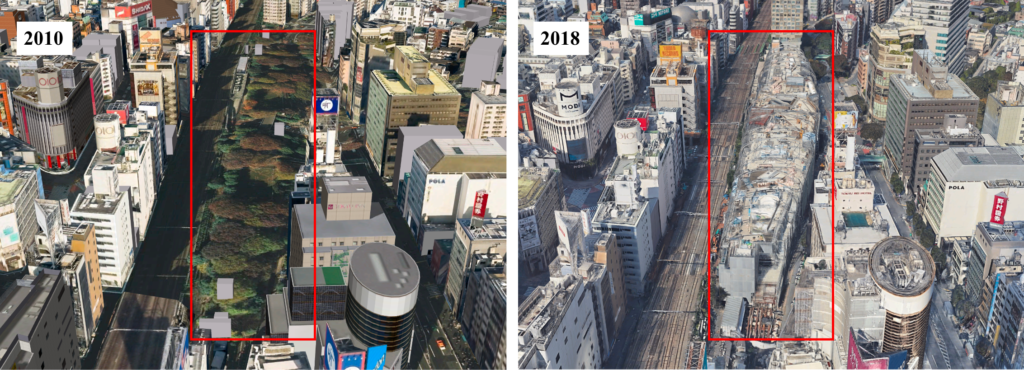
#6

Since the redevelopment of Miyashita Park into a large commercial complex, the weekly soup kitchen that used to serve homeless people there has been moved to the nearby Mitake Park. However, two-thirds of the park is now off-limits due to preparations for a large redevelopment project that is scheduled to go to bid in 2022. Due to the redevelopment, homeless people who live in tents in Mitake Park are threatened with eviction, and the weekly Saturday soup kitchen, for which approximately 150 people gather each week, is again faced with losing its place. Mr. H says, “If this soup kitchen is lost, everyone would be sad. I come here not only for the food but also to see my friends.”
Hardt and Negri argue that in the process of post-modernization, public space is becoming privatized: “the urban landscape is shifting from the modern focus on the common square and the public encounter to the closed spaces of malls, freeways, and gated communities” (2000:188). They also criticize this homogenization and unification of space as a process of social segregation, rather than a process of moving toward a world where social inequality and class are eliminated.
#7
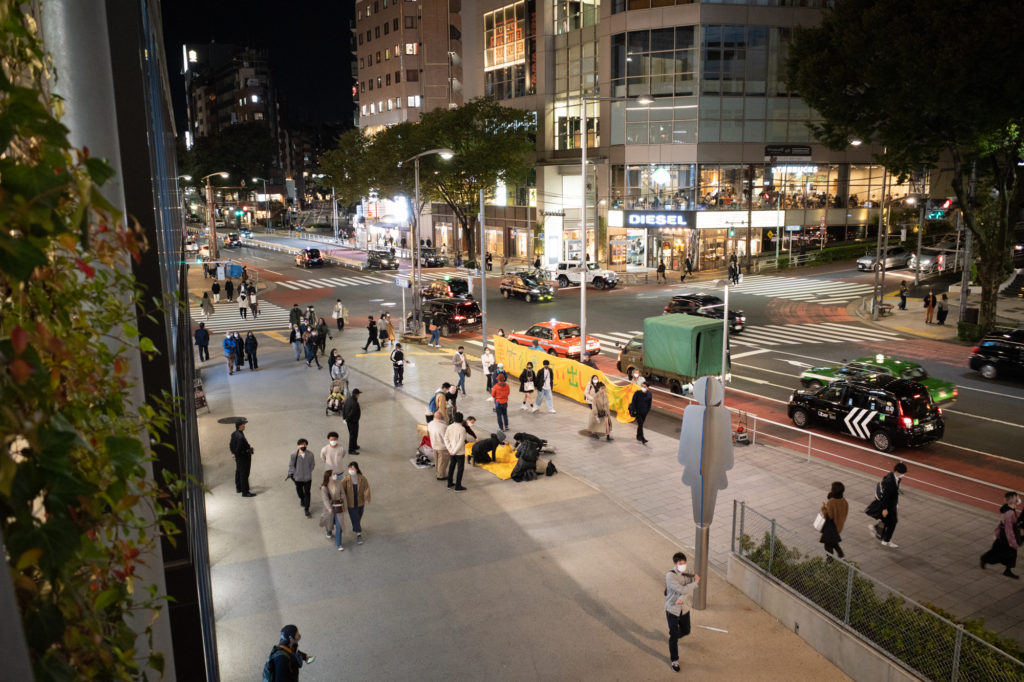
Homeless people and homeless support groups, including Ms. M, regularly hold demonstrations in front of the stores in Miyashita Park to oppose the redevelopment of Mitake Park. Since it is a public space, legally, they have the right to demonstrate there. On the day I was observing the demonstration, as soon as the demonstration started, the staff from the shops and the security guards surrounded the demonstrators even though they could legally do nothing, except looking at the demonstrators with annoyance. During the demonstration, not a single passerby stopped to take an interest in what was happening there.
#8
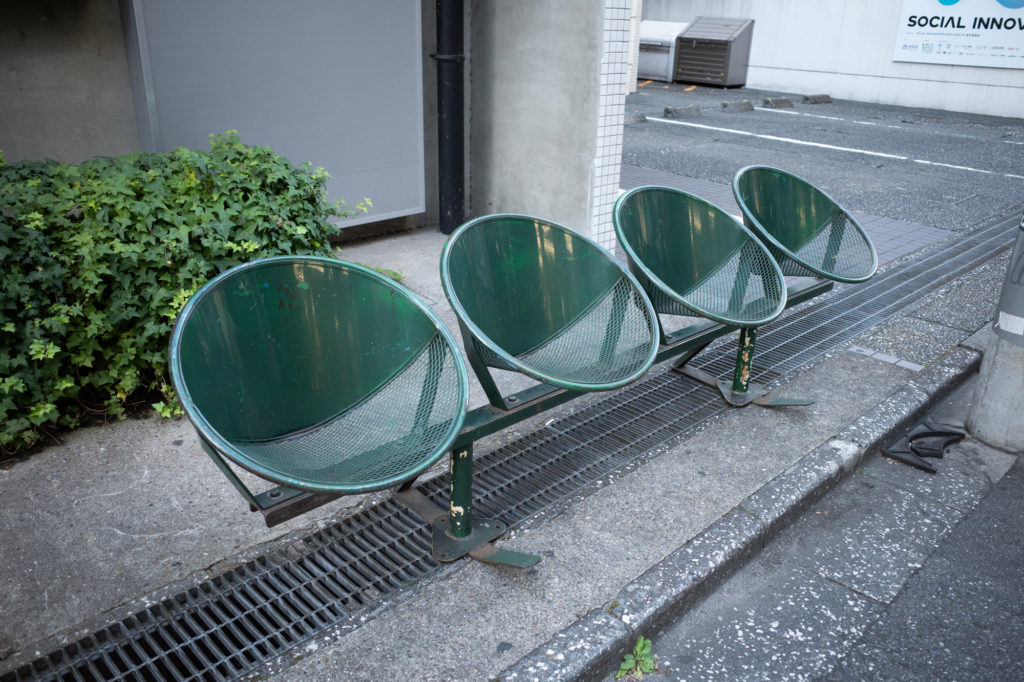
Benches designed to prevent people from staying for a long time are ubiquitous in Shibuya. Mr. H says, “There used to be benches where you could lie down and take a nap, but now there are hardly any benches like that anymore. Well, it makes sense that you shouldn’t do that because it would disturb other people to rest. But it would be nice to have a few benches where you can lie down. There are times when you are just too tired to do anything about it, and just want to take a nap, right? I know you can go home to do so, but we can’t.”
Many of these bench installations are conditioned in city planning from the beginning. For example, the call for proposal of the redevelopment of Mitake Park, being promoted by the Bureau of Urban Development Tokyo Metropolitan Government, states that the redevelopment project aims to create a “socially inclusive park where people can understand each other’s differences.” However, section 6 states, “please give consideration to the design of benches so that people cannot lie down on them.”
#9

Urban design aimed at excluding the homeless is not only expressed as objects, but also as graffiti. For example, in the name of “The Shibuya Arrow Project,” artworks indicating a temporary evacuation place in the case of a disaster are installed in some locations in Shibuya. One arrow artwork graffiti is painted on a wall under the elevated railway tracks near the station. It is certainly eye-catching with its colorful design. Ms. M says, “This art-like paint functions as an anti-homeless spike to discourage the homeless from staying.”
Graffiti is essentially a means of expression to show resistance to authority on the street. Here, however, there is a subversion of meaning in that it is used as a means by the authorities to govern the street.
#10

Kimura points out that the landscape, including the natural environment, is being dramatically and hierarchically reorganized in Shibuya over the past few years (Kimura 2019). Shibuya Scramble Square, which is directly connected to the Shibuya station, is the tallest commercial building in Shibuya, with 47 stories. Its rooftop observatory offers a panoramic view of Tokyo. Most of the redevelopment in Shibuya is for the construction of high-rise buildings. Although the built environment inevitably gets taller in the city center where land prices are high, this also seems to represent spatial classification. “The entrance fee to the rooftop observatory of Shibuya Scramble Square is 2,000 yen, an amount on which we can survive a week or longer,” Ms. M says. However, many people are willing to pay that amount to experience the spectacle.
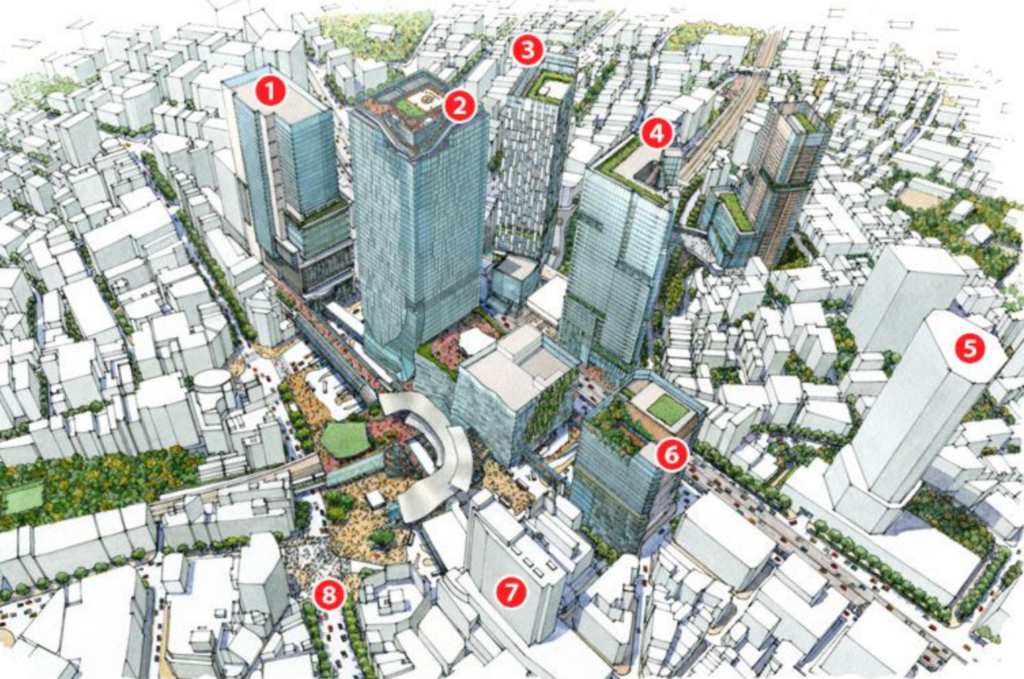
In Tokyo, spatial embodiments of exclusion are steadily leading the homeless into an urban cul-de-sac. While marginal places for the homeless are being taken away, however, the number of people falling into poverty has increased in the last couple of years due to the COVID-19 pandemic. At a soup kitchen in Shinjuku, for instance, the number of people waiting in line has increased from approximately 80 to nearly 500 since the pandemic. The people in the line are diverse and there are only a few people who can be identified as homeless at a glance. One young man who came to the soup kitchen said, “I came here for the first time because I don’t even have enough money to stay at an Internet café. There are no other proper places to sleep on the streets, and I am embarrassed that people would think I am homeless, so last night, I took a nap on a bench at the express bus terminal.” When I went there that night after hearing his story, I found people with large bags sitting or sleeping on the benches next to a huge, sparkling Christmas tree. I wondered if they were waiting for a bus or if they had nowhere else to go and were temporarily resting. The man I had talked to during the day was not there.

< References >
- Appadurai, Arjun. 1996. Modernity at Large: Cultural Dimensions of Globalization. Minnesota: University of Minnesota Press.
- Bhan, Gautam. 2009 “‘This is no longer the city I once knew’. Evictions, the urban poor and the right to the city in millennial Delhi.” Environment and Urbanization, 21(1): 127–142.
- Burchardt, Tania, Julian Le Grand and David Piachaud. 1999. “Social exclusion in Britain 1991-1995.” Social Policy and Administration, 33(3): 227-244.
- Byrne, Byrne. 2005. “Social Exclusion.” In: Issues in Society. May, Tim (eds). Berkshire: Open University Press.
- Gerrard, Jessica, and David Farrugia. 2015. “The ‘lamentable sight’ of homelessness and the society of the spectacle.” Urban Studies, 52(12): 2219-2233. doi:10.1177/0042098014542135
- Gupta, Akhil, and James Ferguson. 1992. “Beyond ‘Culture’: Space, Identity, and the Politics of Difference.” Cultural Anthropology, 7(1): 6–23. http://www.jstor.org/stable/656518.
- Greene, Solomon. J. 2003. “Staged cities: mega-events, slum clearance, and global capital.” Yale Human Rights & Development Law Journal, 6:161–187.
- Hardt, Michael, and Antonio Negri. 2000. Empire. Cambridge: Harvard University Press.
- Kimura Masato. 2019. “Privatization and Protest of Commons: On the Gentrification and Homeless Movement in Shibuya.” Space, Society and Geographical Thought, 22: 139-156.
- Levi-Strauss, Claude. 1992. Tristes Tropiques (second eds). London: Penguin Books.
- Massey, Doreen. 2005. For Space. London: Sage.
- Mesquita, André. 2018. “Counter-Cartographies: Politics, Art and the Insurrection of Maps.” In: This Is Not an Atlas: A Global Collection of Counter-Cartographies. Kollektiv Orangotango.
- Newton, Caroline. 2009. “The reverse side of the medal: about the 2010 FIFA World Cup and the beautification of the N2 in Cape Town.” Urban Forum, 20(1): 93–108.
- Shin, Hyun. 2012. “Unequal cities of spectacle and mega-events in China”. City, 16: 728-744. 10.1080/13604813.2012.734076.
- Wood, Denis. 2012. “The Anthropology of Cartography.” In: Mapping Cultures. Roberts L. (eds). Palgrave Macmillan, London.